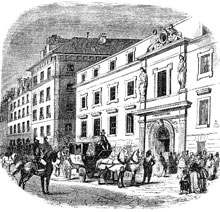The Institutionalization of Music Education by Pemi Paull
/ October 1, 2011
Version française...
Flash version here.
 During the period of
history between the Middle Ages and the French Revolution, music was
deeply integrated into the fabric of life. Cultivating an understanding
of music was considered a basic component of general education. In the
past two centuries, there has been a gradual shift in the role music
plays in our lives. With regard to the training of musicians, prior
to the French Revolution music instruction was typically done on a master-apprentice
basis, one-on-one. Just as a craftsman was taught, a pupil would go
study with a master to learn the “trade”, the master’s approach
to making music. During the period of
history between the Middle Ages and the French Revolution, music was
deeply integrated into the fabric of life. Cultivating an understanding
of music was considered a basic component of general education. In the
past two centuries, there has been a gradual shift in the role music
plays in our lives. With regard to the training of musicians, prior
to the French Revolution music instruction was typically done on a master-apprentice
basis, one-on-one. Just as a craftsman was taught, a pupil would go
study with a master to learn the “trade”, the master’s approach
to making music.
Typically this
would involve the study of composition, singing, learning a musical
instrument, and also the study of rhetoric. A constant theme in writings
on music, especially in the age of Baroque music, from about 1600 to
the last decades of the 18th century, states that music is
a language in tones, involving dialogue and dramatic confrontation.
The apprentice had to learn his art in all its aspects, not merely how
to play an instrument or sing, but also how to present music convincingly.
With the French
Revolution came a great upheaval, which also affected the study of music.
Not only musical training as a whole, but musical life itself, was given
a fundamentally new orientation. The relationship between master and
apprentice was replaced by a system, an institution: the Conservatoire,
founded in 1795. The new French method involved comprehensively unifying
style down to the last detail, and in line with the new political ideals
of the times, creating music that spoke directly to the emotions of
the people with the simplest and most accessible means possible.
In 1822, Luigi
Cherubini, who had previously been Napoleon’s director of music in
Vienna, became the director of the Conservatoire de Paris, where he
commissioned the great musical authorities of the time to compose didactic
works, which were supposed to embody the new ideal of égalité
in music. And so, Baillot wrote his violin method and Kreutzer wrote
his etudes. Indeed, all the most important teachers in France were enlisted
in the project of formulating these new ideas into a universal system
of music education. Out of this arose a codification of technique, and
the pictorial replacing the verbal, or rhetorical, elements of music.
This is how the sostenuto, the sweeping melodic line, the modern legato
came about. This revolution in musical training was carried out so radically
that within a few short decades, musicians all over Europe were being
trained in accordance with the system of the Conservatoire. To a large
extent musicians continue to be trained this way today.
Undoubtedly, some
positive developments have resulted from the systematization of music
education. One of the best examples is the publicly funded voluntary
musical training program in Venezuela, El Sistema, a state foundation
that watches over Venezuela’s 125 youth orchestras and the instrumental
training programmes which make them possible. Its greatest achievements
are the 250,000 children who attend its music schools around the country,
90 percent of them from poor socio-economic backgrounds. The fact that
a relatively impoverished nation such as Venezuela is able to demonstrate
to the world that it is possible to make music education a priority
for its young people on such a large scale offers great hope for the
future of music. This is especially true at a time when music education
funding is shrinking in Europe and North America.
Nonetheless, the
times in which we live require professors within the conservatoire system
not to be limited to teaching the student how to produce a beautiful,
even tone, with clean execution and steady rhythm, where the goal of
getting a post in a university or a job in an orchestra is paramount.
Unlike the musicians of the past, today’s students are expected to
perform music from four centuries, and should study and experiment with
the performance practices of whatever music they are absorbing.
Developing an understanding—preferably
an enthusiasm—for the music of our time, and some experience in improvisation
is also a necessity. In the past, the study of music was the study of
a living art, an art rooted in the culture of the present. The goal,
in the end, must be to teach young musicians to understand and communicate
the different languages of music rather than to homogenize music in
order that beauty and perfection become priorities. In this way, the
separation between “popular” and “serious” music, and, ultimately,
between music and time will disappear and cultural life will once again
form a whole.
Version française... |
|


